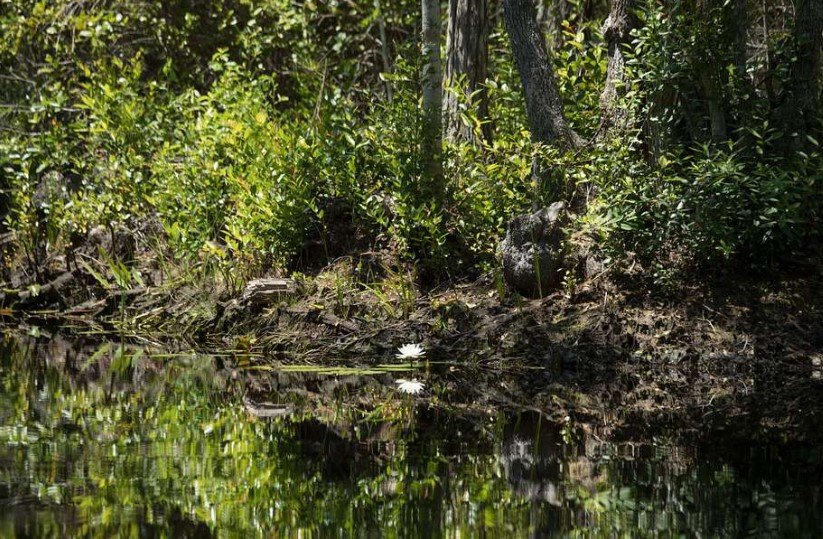The Okefenokee Swamp—a timeless, starlit sanctuary brimming with life—might soon find itself staring down bulldozers. A titanium mine could change everything.
The kind of silence you feel in the Okefenokee isn’t really silent. It’s full—of frogs croaking like fireworks, birds drumming the trees, and the low call of barred owls echoing in the dark. The swamp has its own soundtrack. And that music, as etched on a bench deep within it, “has music for those who listen.”
Mining Inches Closer to Georgia’s Wild Heart
It’s not just any swamp. The Okefenokee is massive, stretching more than 400,000 acres across southeast Georgia and into Florida. It was designated a National Natural Landmark in 1974 and is now the largest National Wildlife Refuge east of the Mississippi.
An Alabama-based company, Twin Pines Minerals, wants to open a titanium dioxide mine just 2.9 miles from the Okefenokee’s border. The mining operation would run 24/7, churning out noise, lights, and industrial waste right next to one of the quietest and darkest places in the South.
That doesn’t sit well with scientists, conservationists, or thousands of Georgians who’ve spoken out.

Not Just Noise: Hydrology on the Brink
What makes this mine especially risky isn’t just its proximity—it’s the fragile land it targets. Trail Ridge, where the mining would happen, is more than a boundary. It’s a natural dam, keeping the swamp’s water levels stable.
Digging 50-foot-deep pits into Trail Ridge could change how water flows—forever. Scientists warn that drawing groundwater, disturbing aquifers, and changing surface contours might lower the swamp’s water table.
That could dry out the ecosystem. And that’s dangerous.
-
Lower water levels increase wildfire risk, like the 2017 West Mims Fire that torched over 150,000 acres and cost $45.5 million to contain.
-
Drier peat soils release carbon into the atmosphere, adding fuel to climate change instead of helping slow it.
-
Vital wetland habitats could vanish, leaving countless species without a home.
And this wouldn’t be a one-off project. Twin Pines eventually hopes to mine roughly 8,000 acres in multiple phases, expanding ever closer to the swamp’s edge.
Who’s Standing Up for the Swamp?
From scientists to stargazers, the swamp has its defenders.
Jennette Gayer, the State Director for Environment Georgia, has been one of the most vocal. She calls the Okefenokee “magical,” pointing to its rich biodiversity and the dazzling views of the Milky Way overhead.
“The earth has music for those who listen,” she said, quoting the phrase carved into that now-famous wooden bench.
More than 100,000 public comments have been submitted opposing the mine. The U.S. Fish and Wildlife Service has raised red flags. The Okefenokee Protection Alliance—an umbrella of environmental groups—has rallied support statewide.
Numbers Don’t Lie: What’s at Stake?
A closer look at the swamp’s value shows why so many are pushing back.
| Feature | Detail |
|---|---|
| Refuge Size | ~400,000 acres |
| Designation | National Wildlife Refuge (largest east of the Mississippi) |
| Economic Impact | ~$64 million/year in tourism and recreation |
| Biodiversity | Home to 620 plant species, 233 bird species, 49 mammals |
| Carbon Sequestration | Thousands of acres of carbon-rich peat soil |
| Public Comments on Mining | Over 100,000 (mostly against) |
| Fire Suppression (2017) | $45.5 million (West Mims Fire) |
And don’t forget: the Okefenokee draws more than 600,000 visitors each year. From school kids to birdwatchers, everyone comes for a piece of the wild.
The Stars, the Frogs, and the Future
Here’s the thing. If you’ve never been to the Okefenokee, it’s hard to grasp just how different it is.
At night, it glows—not from lights, but from the stars. The International Dark Sky Association calls it the “most brilliant” night sky in the Southeast. That darkness? It’s endangered too. Constant floodlights from a mine could wipe it out.
Pig frogs boom from the water like bass drums. Sandhill cranes echo across the sky. And somewhere out in the cypress trees, you’ll hear the lonely call of an owl.
Lose the swamp’s silence, and we lose those sounds. Maybe forever.
One sentence here again: It’s a hard thing to measure—what a place feels like—but everyone who’s been there gets it.
What Happens Next?
Georgia regulators still have the power to stop this.
The state’s Environmental Protection Division is reviewing the permits. Meanwhile, environmental groups are calling for federal protection through the U.S. Department of the Interior. Some lawmakers have even proposed giving the Okefenokee permanent protection under the National Park Service.
